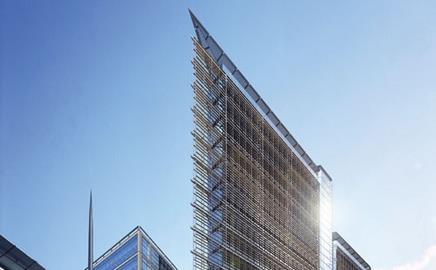As pressure mounts for suppliers to improve energy efficiency, Italian cladding maker Permasteelisa explains how it’s doing its bit for the environment.
Permasteelisa Group is the largest maker of cladding systems in Europe. Based in Vittorio Veneto, Italy, it employs about 5,200 people and its worldwide commercial sector turnover is more than £700m. Giancarlo Iovino, managing director of the company’s UK division, tells Building about the challenges facing the industry – particularly regarding sustainability – and the innovations it is working on to respond to them.
Which sectors do you work in?
Most of the work we cover would be in the commercial sector, PFI and health, as well as higher end residential projects.
What are the main drivers in your business?
In a sense, the standardisation of process. We would like to develop greater consistency in manufacturing and detailing so that even though the aesthetic may be different between projects, the principles remain the same.
We fabricate and assemble our panels in the factory and are driving towards minimising site work. We want to optimise cladding solutions to increase efficiency.
We are also seeking to minimise our construction waste.
What regulation has had a direct effect on your business?
The regulations that focus on energy efficiency have been in place for a while, which puts more pressure on our products to perform. They are also forcing a more holistic approach to how energy efficiency is calculated. We’re having to look at the CO2 output of a whole building over its lifetime rather than just individual components. All our developments are specification-driven, reacting to client and consultant needs.
What innovations are you working on?
There are several we have been working on to boost thermal performance and security. Our argon-filled double-glazed units provided an initial step forward but we are now looking at creating vacuums between panels. This would increase the performance of the cladding drastically. Double-skin facades have an enormous effect on the thermal performance of buildings, which is an issue clients should bear in mind.
For blast protection, it’s all about the nature of the laminate interlayer, which we are developing. Mullion and bracket design can also contribute to increasing performance in this regard.
How are you dealing with sustainability?
We are fully signed up to ISO 14000, which focuses on sustainability issues, reducing consumption and waste.
Learning how to manage the process takes you part way to learning how it can be improved.
What are your lead times?
It varies depending on the complexity of the job. A small job for us would have a contract value of about £3m and we could be on site within seven months. Larger jobs can be in the order of about two years but lead times wholly depend on our suppliers’ ability to deliver the materials on time and in the quantities we require.
Postscript
For more information on sustainability, log on to www.building.co.uk/sustainabletoolkit
Topics
Specifier 2 March 2007
- 1
- 2
- 3
- 4
- 5
- 6
- 7
- 8
- 9
- 10
- 11
- 12
- 13
 Currently reading
Currently readingWe’ve got it covered ...
- 14

































No comments yet